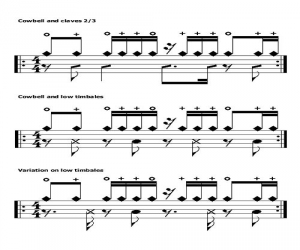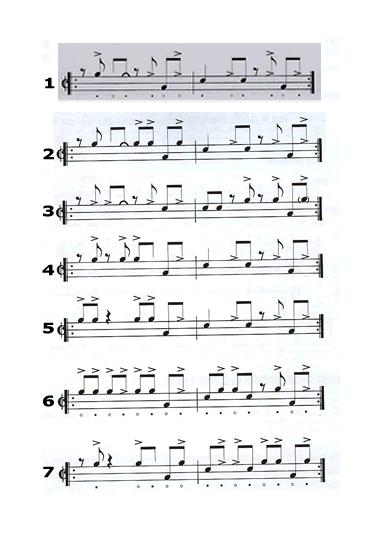
Guaguanco by Lamy
- April 23, 2017
- 16965 downloads
Description
This is just an extract of the instructional book by Laurent Lamy: 7 patterns. The original version contains text with instruction on how to perform the rhythms and the audio files!! Contact the author for more info or visit the store.
by Laurent Lamy
Thank to the author this score is also available into the InstrumentBook where you can find other stuff for this instrument: click here.
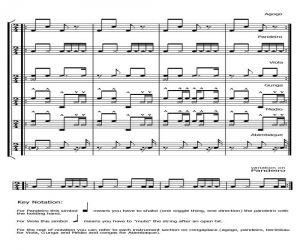
mySCORE
Angola (Capoeira Bateria)
- June 04, 2014
- 2756 downloads
- 0 Comments
- Read score
Description
Gunga initiates the Jogo (Game) by playing constant open 16th notes, (as shown at the bottom), then comes Medio, and then Viola,(all enter in apprixcimately the same way, 16th notes, or sometimes 8th notes in triple). If a ladainha is sung then, (which is usually the case in Angola), other instruments enter only when the chorus begins, in this order: pandeiro, atambaque, agogo, reco reco. Sometimes the instruments come in before the ladainha begins, these has usually to do with personal preference, and how it is done at different Grupos differs. This is how I'v learn't and understood the rhythms, and how I'v found they sound good. Theres about as many ways of playing, and combining these rhythms as there are Mestres, if not even more. When the actual playing begins the Mestre de Roda,(playing Gunga), dips the head of the Berimbau while playing constant 16th notes. This initiates the game. Only to mark the begining of each game is the gunga dipped, but otherwise all signals are the same, to end each game and to end the whole Jogo. All the signals are played long enough to catch the attention of the players. Most variations (improvisation), is done by viola but medio and gunga also do variations according to the feeling. In São Bento Grande all insruments enter before the songs begin. In the rhythm noted the third bar is a variation and is not compulsory and not even advisable to play all the time. Pandeiro can play the rhythms bar two is just a variation of bar one, (plus when playing for long periods of time its easier). The noted viola rhythm is called Angolinha, and the noted Medio rhythm in Angola is called São Bento Pequena.
by Timo Tuhkanen
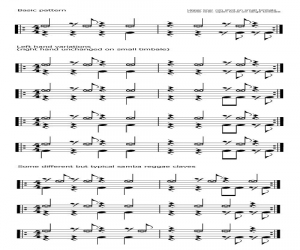
mySCORE
Samba Reggae
- June 04, 2014
- 2588 downloads
- 0 Comments
- Read score
Description
Brazialian rhythm played on timbales. The rhythm can be heard on "The Obvious Child" on the CD "The Rhythm of the Saints" by Paul Simon. For these rhythms to sound right you have to tune you small timbale realy high and your large timbale fairly low. The rhythms emulate the repenique and surdo all together and are best played with a bundle of thin rods (tamborim stick) as a stick in the right hand playing only rimshots on the small timbale and a normal good solid stick in the left hand.
by Christian Velasquez

mySCORE
Songo Bells
- June 04, 2014
- 2308 downloads
- 0 Comments
- Read score
Description
Songo bells pattern for timbales

mySCORE
Songo
- June 04, 2014
- 2391 downloads
- 0 Comments
- Read score
Description
Pattern for timbales: Songo uses a downbeat bell pattern for the right hand and a syncopated pattern for the left hand that may play several instruments. Also songo is supposed to be played with bassdrum. My songo pattern can be found in books like the one from frank Malabe or Robby Ameen
by Manfred Mirsch
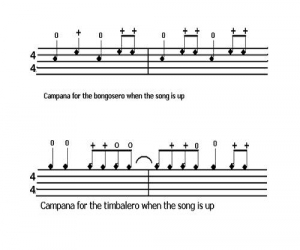
mySCORE
Son Bells
- June 04, 2014
- 2285 downloads
- 0 Comments
- Read score
Description
Son Bells patterns for timbales
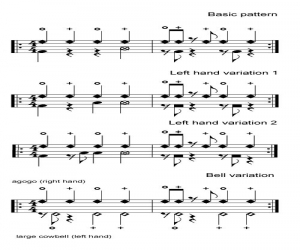
mySCORE
Maracatù
- June 04, 2014
- 2441 downloads
- 0 Comments
- Read score
Description
Norhtern Brazil rhythm played on timbales. The bell pattern can be played on either the large bell or a mounted agogo bell. The bell variation can be played in the left hand together with the first bell pattern in the right hand simultaneously. The two muffled strokes in the left hand variation works best as press roles or if you hit the large timbale near the rim without making a rimshot. The important thing is that the two strokes are slightly higher pitched than the first stroke on one.
by Christian Velasquez
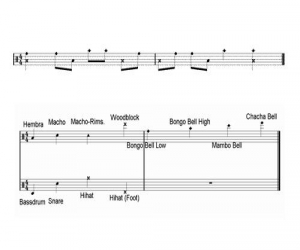
mySCORE
Conga Habanera
- June 04, 2014
- 2451 downloads
- 0 Comments
- Read score
Description
Pattern for timbales: the bell should have two different sounds and the left hand would either play rumba-clave on another bell or immitate the bombo rhythm.
By Manfred Mirsch

mySCORE
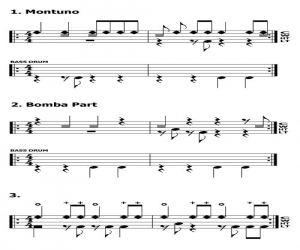
mySCORE
Timba
- June 04, 2014
- 2428 downloads
- 0 Comments
- Read score
Description
3 Timba patterns for timbales
C= Cowbell - W=Woodblock - HT=High Tom - LT=Low Tom
by Laurent Lamy
